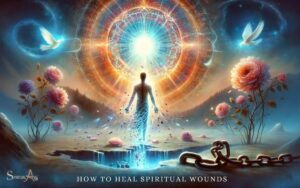Difference Between Reiki and Spiritual Healing: Comparison!
Reiki and spiritual healing are two distinct practices that aim to facilitate wellness and balance within individuals.
Reiki is a Japanese technique that involves the practitioner placing their hands on or near the body to channel universal life energy to the recipient. It is known for its structured methodology and use of specific symbols.
Spiritual healing, in contrast, is a broader term that can encompass various traditions and practices, often involving the healer’s intuitive connection with spiritual entities or forces to restore well-being.
Reiki is a specific form of energy healing with a defined set of practices and symbols that are taught through levels of attunement.
Practitioners believe in a universal life force that they can channel to support healing:
Explore the paths of Reiki’s structured energy work and the intuitive practices of spiritual healing to find your harmonious state of well-being.
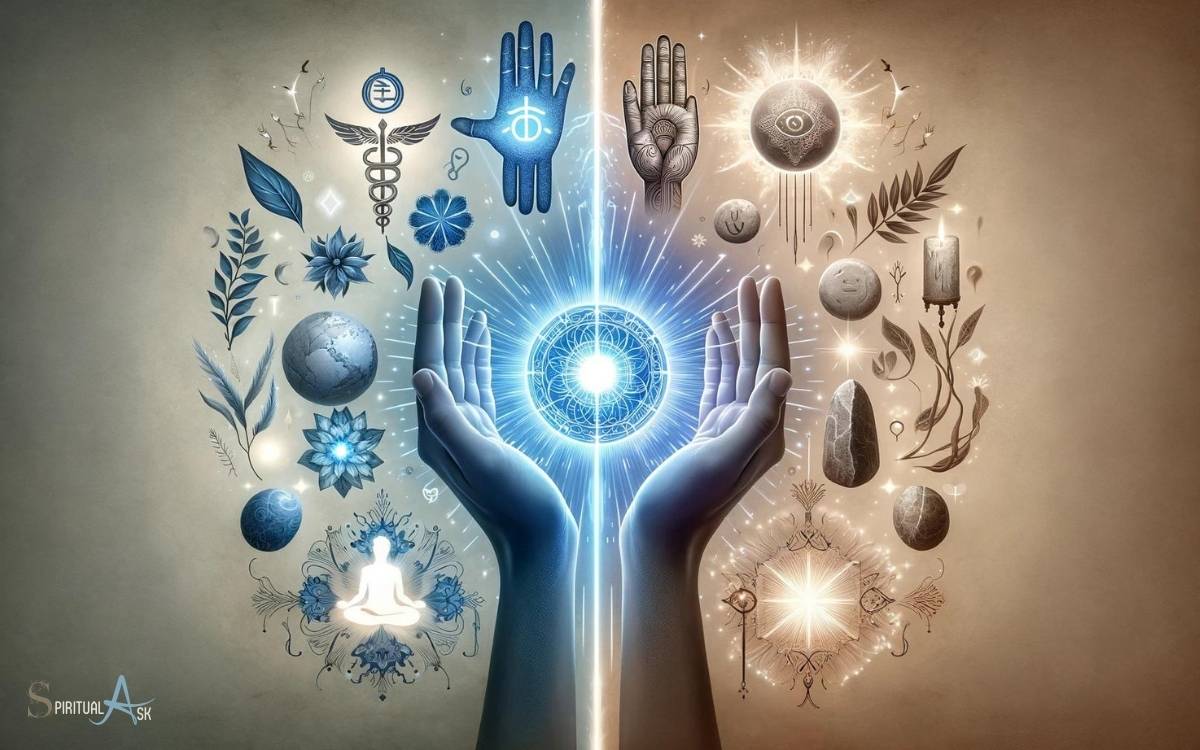
Key Takeaway
7 Key Aspects: Difference Between Reiki and Spiritual Healing
| Aspect | Reiki | Spiritual Healing |
|---|---|---|
| Definition | A healing technique based on the principle of channeling energy into the patient by means of touch. | A healing practice that involves the transfer of energy from a higher power or the universe to help heal the individual. |
| Origin | Japan in the late 1800s | Various cultures and spiritual traditions throughout history |
| Methodology | Laying on hands with specific hand patterns and symbols. | Varies widely; may include prayer, meditation, or communication with spirits. |
| Attunements | Yes, practitioners receive attunements to access Reiki energy. | Not typically structured around attunements. |
| Tools/Symbols | Use of specific Reiki symbols learned through training. | May employ a variety of tools such as crystals, oils, or none at all. |
| Practitioner’s Role | Channel universal life energy through hands-on technique. | Facilitate healing by connecting to spiritual or divine sources, often personalized to the healer’s beliefs. |
| Touch Required | Yes, but can also be performed at a distance. | Not necessarily; depends on the specific practice. |
Origins of Reiki and Spiritual Healing
The origin of Reiki and spiritual healing can be traced back to ancient practices and belief systems. Reiki, a Japanese healing technique, finds its roots in the teachings of Mikao Usui in the early 20th century.

Usui drew inspiration from Buddhist sutras, Taoist philosophies, and traditional Chinese medicine.
Spiritual healing, on the other hand, has been practiced across cultures for centuries, with references in ancient texts and scriptures. Spiritual healing is often deeply rooted in traditions, rituals, and beliefs that connect individuals to a higher power or universal energy. While its practices may vary—from prayer and meditation to energy work like Reiki—its purpose remains the same: to restore balance and promote overall well-being. For those seeking to explore this ancient practice, a common question arises: how much spiritual healing costs, as the value and accessibility of such services can differ widely depending on the practitioner, location, and specific methods employed.
It is based on the concept of an unseen life force energy that flows through all living beings, affecting their health.
This vital force has been known by different names in various cultures, such as prana in Hinduism and qi in traditional Chinese medicine.
Both Reiki and spiritual healing share the common principle of promoting balance and harmony within the body, mind, and spirit.
Principles and Beliefs
When it comes to understanding the principles and beliefs behind Reiki and spiritual healing, it’s essential to consider the methods used to channel energy, the practices that foster spiritual connection, and the intentions and techniques employed in the healing process.

These aspects provide insight into the foundational elements that shape the philosophies and approaches of both modalities, shedding light on their unique characteristics and applications.
By examining these points, we can gain a deeper understanding of the underlying principles and beliefs that guide Reiki and spiritual healing practices.
Energy Channeling Methods
In energy channeling methods, my focus is on understanding the principles and beliefs underlying the practice.
The fundamental principle is that everything is energy, and this energy can be channeled, balanced, and manipulated to promote healing and well-being.
Believers in energy channeling methods often embrace the concept of a universal life force that permeates all living things, known as prana, chi, or ki in various traditions.
The practice is based on the idea that this life force can be harnessed and directed by the practitioner to support the body’s natural healing processes.
Additionally, there is a deep-seated belief in the interconnectedness of mind, body, and spirit, and the role that energy flow plays in maintaining holistic health.
Spiritual Connection Practices
Experiencing the interconnectedness of all life forces is fundamental to spiritual connection practices. It’s about recognizing that every living being is interconnected and that we are all part of a larger, universal energy.
Spiritual connection practices are based on the principle that we can tap into this universal energy to promote healing and balance. Many spiritual connection practices emphasize the belief in a higher power or universal life force that guides and supports us.
This belief forms the foundation for practices such as prayer, meditation, and visualization, which are used to connect with this higher power and seek guidance, healing, and inner peace.
Additionally, spiritual connection practices often involve cultivating qualities such as love, compassion, and gratitude, as these are seen as essential for fostering a deeper connection with the universal energy and promoting healing.
Healing Intentions and Techniques
I’m passionate about using healing intentions and techniques to channel and direct universal energy for promoting balance and well-being.
In spiritual healing, the belief is that the practitioner acts as a channel for healing energy to flow through them to the recipient.
The intention is to address the root cause of the imbalance and promote healing on all levels – physical, mental, emotional, and spiritual.
Techniques used may include energy channelling, laying on of hands, visualization, and the use of sacred symbols or rituals. It’s essential to approach the process with pure intentions, compassion, and a deep sense of connection to the universal source of energy.
The belief in the interconnectedness of all living beings and the power of love and compassion to facilitate healing is fundamental to these practices.
Techniques and Practices
When it comes to techniques and practices in Reiki and spiritual healing, there are key points to consider.
Energy channeling methods, holistic healing approaches, and the significance of spiritual connection are all fundamental aspects to explore.
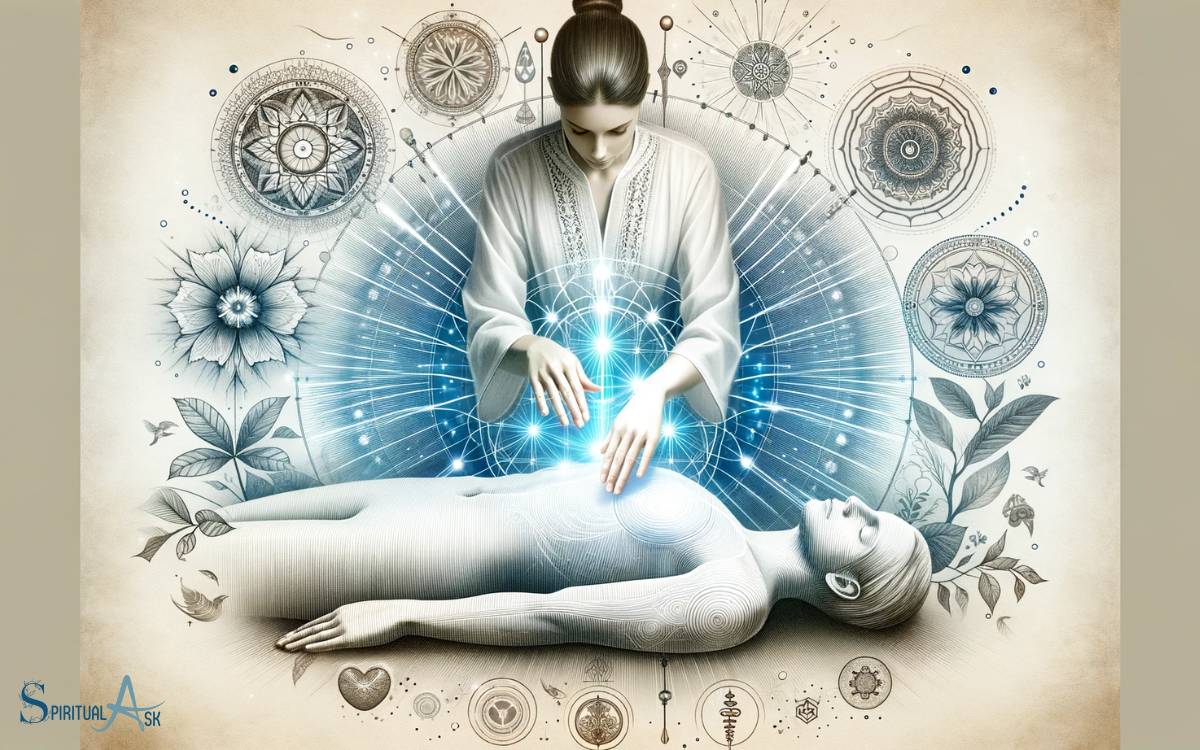
These elements form the foundation of how these two healing modalities are practiced and how they aim to bring about healing and balance.
Energy Channeling Methods
In energy channeling, I utilize specific techniques and practices to facilitate the flow of healing energy.
To harness and direct this energy, I employ the following methods:
- Visualization: I visualize the energy flowing through me and towards the recipient, guiding its path and focusing on its healing properties.
- Breathwork: I use controlled breathing techniques to help regulate the flow of energy, allowing it to move smoothly and consistently.
- Intention Setting: By setting clear intentions for the energy to provide healing and support, I aim to direct its effects towards the recipient’s specific needs.
These methods, when combined, create a focused and intentional channel for healing energy to flow through, promoting overall well-being and balance.
Holistic Healing Approaches
Utilizing holistic healing approaches, I channel healing energy through a combination of techniques and practices aimed at promoting overall well-being and balance.
This includes integrating modalities such as meditation, crystal therapy, aromatherapy, and sound healing into my practice.
Meditation helps in calming the mind and promoting mental clarity, while crystal therapy harnesses the energy of crystals to restore balance.
Aromatherapy utilizes the scents of essential oils to enhance emotional and physical well-being, and sound healing uses vibrations to create a sense of harmony within the body.
These holistic techniques work in synergy to address the physical, emotional, and spiritual aspects of an individual, aiming to promote healing on all levels and restore equilibrium.
By combining these diverse practices, I create a comprehensive and personalized approach to holistic healing.
This holistic approach serves as a foundation for understanding the significance of spiritual connection in the healing process.
Spiritual Connection Significance
Frequently, I incorporate spiritual connection practices into my holistic healing approach to promote overall well-being and balance.
These practices are essential in fostering a deep connection with the spiritual realm, which I believe is integral to achieving holistic wellness.
Here are three significant techniques and practices that I find particularly impactful:
- Meditation: Engaging in regular meditation allows for a quieting of the mind, creating space for spiritual connection and insight.
- Energy Clearing: Utilizing techniques such as smudging or energy healing to clear any negative or stagnant energy, allowing for a more open and vibrant spiritual connection.
- Connection Rituals: Engaging in rituals such as setting intentions, prayer, or connecting with nature to deepen the spiritual connection and invite positive energies.
Energy Channels and Chakras
Understanding the interconnectedness of energy channels and chakras is fundamental to both Reiki and spiritual healing practices.
In Reiki, it is believed that there are specific energy channels running through the body, and these channels need to be clear and balanced for optimal health and well-being.
Chakras, on the other hand, are thought to be the energy centers within the body, each governing specific aspects of our physical, emotional, and spiritual selves.
Spiritual healing also emphasizes the importance of these energy channels and chakras, focusing on unblocking and balancing them to promote healing.
Both practices view the body as a complex energy system where disturbances or blockages in the energy flow can lead to physical or emotional imbalances.
By working with these energy channels and chakras, both Reiki and spiritual healing aim to restore harmony and promote overall wellness.
Intended Healing Outcomes
When practicing Reiki, my primary goal is to facilitate the flow of universal life force energy to promote relaxation and encourage the body’s natural healing processes.
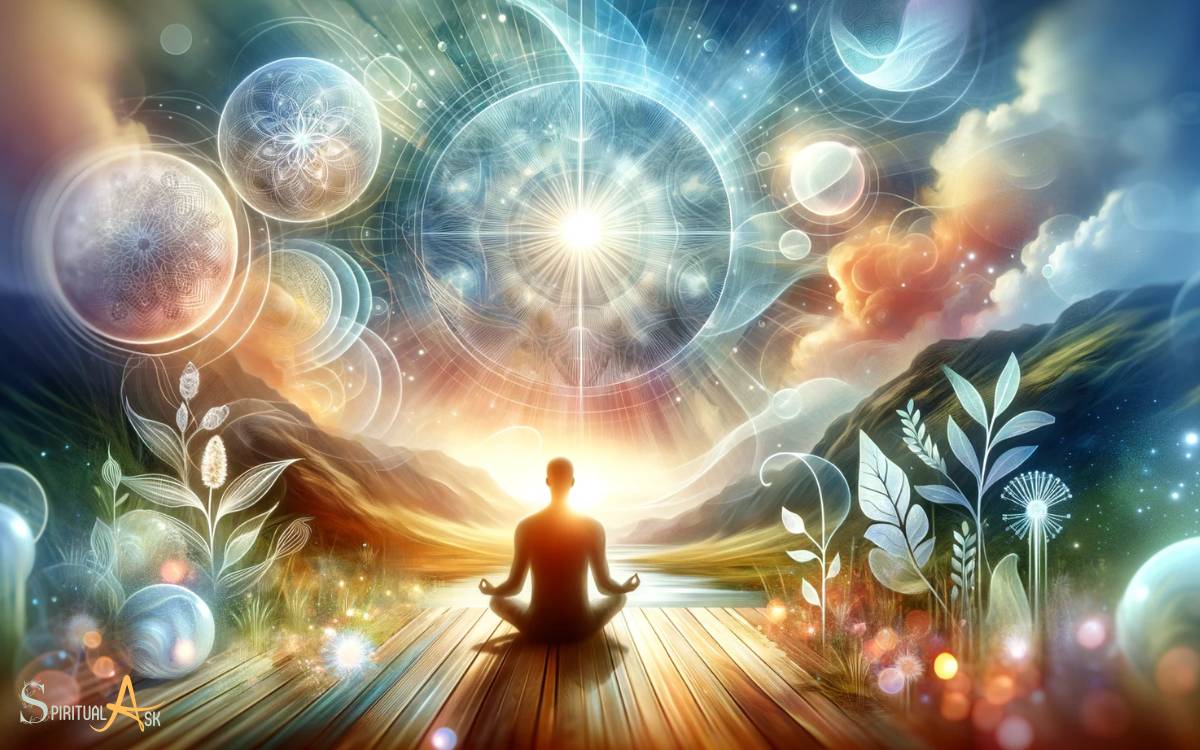
The intended healing outcomes of Reiki include:
- Stress Reduction: By channeling energy, Reiki aims to reduce stress and promote a sense of calm and well-being.
- Pain Relief: Reiki seeks to alleviate physical discomfort by addressing energy imbalances within the body.
- Emotional Balance: Reiki endeavors to restore emotional equilibrium, supporting individuals in processing and releasing negative emotions.
These outcomes are sought through the gentle laying on of hands and the transfer of energy to support the body’s innate capacity for healing.
As a result, individuals often experience a sense of peace, improved vitality, and enhanced overall wellness.
This approach aligns with the holistic nature of Reiki and its focus on promoting harmony and balance within the individual.
Integration With Other Modalities
My experience has shown that integrating Reiki with other healing modalities can enhance the overall therapeutic effects. When combined with massage therapy, for example, Reiki can deepen relaxation and help release tension more effectively.
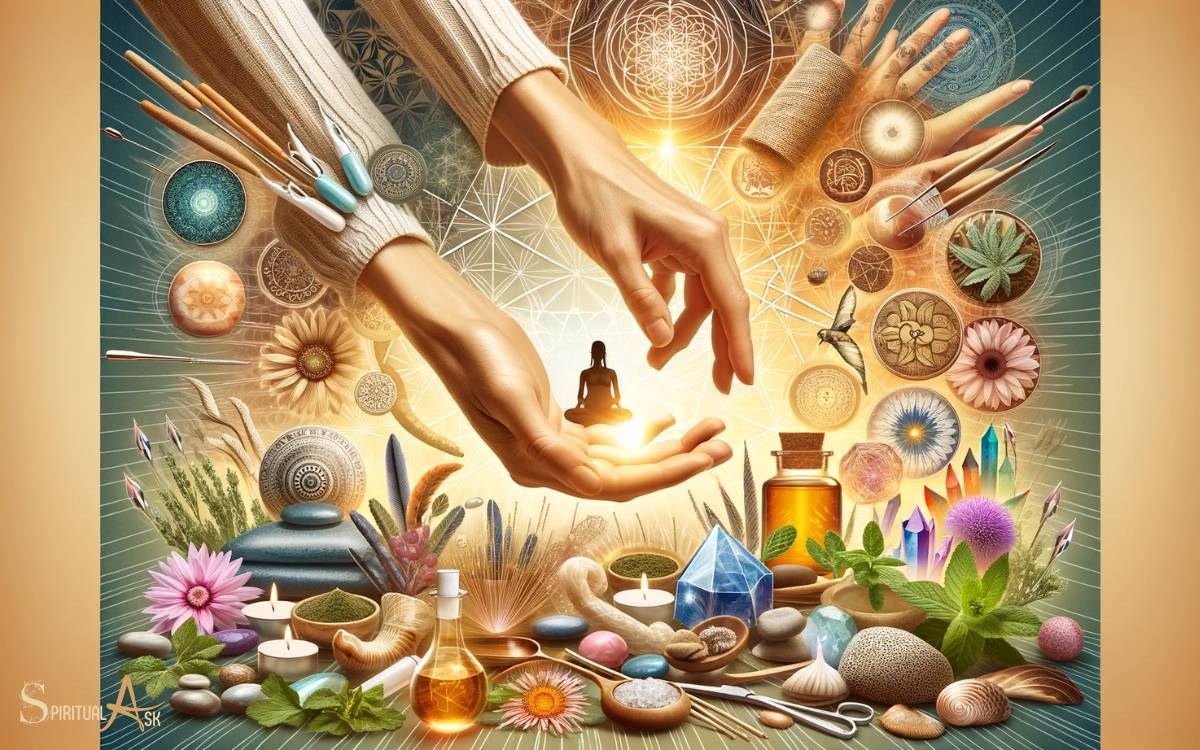
Similarly, incorporating Reiki into acupuncture sessions may promote a stronger flow of energy throughout the body, potentially enhancing the benefits of both practices.
Additionally, blending Reiki with traditional medicine can provide a more comprehensive approach to healing, addressing not only the physical symptoms but also the underlying energy imbalances.
Integrating Reiki with other modalities allows for a holistic approach to wellness, addressing the physical, emotional, and energetic aspects of healing.
It’s important to work with practitioners who are open to collaboration and have a good understanding of how different modalities can complement each other for the best possible outcomes.
Conclusion
While Reiki and spiritual healing share some similarities in their focus on energy and intention for healing, they also have differences in their origins, techniques, and beliefs.
It’s fascinating to note that a survey conducted by the National Center for Complementary and Integrative Health found that over 1.2 million adults in the United States have used energy healing therapies, including Reiki and spiritual healing, showing the growing interest in these modalities for holistic wellness.





